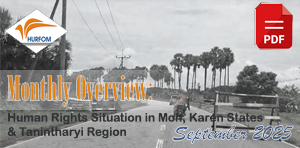Mon National Day is celebrated in Burma
February 22, 2008
Loa Htaw, IMNA,
Ten birds were released in Mudon Township, Mon state, on the 61st annual Mon National Day (MND). The birds were a symbol of peace for everyone in the world, said Mon people who attended the celebration.
“We want every life in the world to have peace,” said Dr. Soe Lin, the chairman of Central Celebrating Committee of the Mon National Day (CCCMND), which was responsible for releasing the birds. Dr. Soe Lin is also secretary of the Mon National Democratic Front and a former political prisoner. He added that the birds represented an especially important symbol of peace for people in Burma right now, pointing to recent assassinations of opposition leaders in Pakistan and the Karen National Union in Karen state, Burma. “We don’t want others in Burma to see a similar fate,” he said.
The birds were released in Mudon Township, and while 2008 marked the 61st MND, it also marked the first time Mudon Township acted as a central celebration place. About twenty community leaders fro m each township also attended the central MND celebration.
m each township also attended the central MND celebration.
“Mon people have to struggle for themselves to exercise their right to self-determination,” said Dr. Soe Lin at the celebration. “On this 61st anniversary Mon National Day our people have experienced both happiness and dissatisfaction and continue to face difficulties in our future,” he said. “We have to pass through the difficulties with the unity and strength of a people together, not as individuals alone,” he added.
Before this MND youth were able to actively take part in preparations, selling national day lottery tickets and Mon flags as fundraisers across Mon state. The CCCMND has always encouraged Mon youth to take part in national activities.
Until this year the junta had restricted the participation of Mon youth, limiting travel and banning the sale of lottery tickets and Mon flags. But MND is still not an official Burmese holiday, and Mon students in grades six to nine had to spend the day taking exams.
A teacher teaching Basic Education in Moulmein said that the order came from higher authorities through the Mon State Education Department. The teacher said that he did not think it was a coincidence that the exams were scheduled on MND. The order said no schools could close on February 22nd and schools in rural areas would spend the day taking the test. The fact that the order specifically targeted rural schools is a fair indicator of the true motivation for the policy, as it is rural areas that show the strongest interest in Mon national issues.
Students at the Kamawet Village high school, Mudon Township, attended school but wore Mon national dress in protest, said witnesses in the area. Students are banned from wearing Mon national dress in junta schools and the act served as a strong statement of the student’s anger at being prevented from attending the MND celebration.
In spite of the junta’s quiet attempts to undermine the festival, many felt MND was a success. “This year more people celebrated Mon National Day and almost all of them held Mon flags as they marched during the celebrations,” Dr. Soe Lin said. “Almost all the clothes stores in Mon state ran out of Mon national dress.”
The CCCMND held MND celebrations in nineteen townships and villages in Mon and Karen state, as well as several places where there are strong Mon communities, including Pegu and Rangoon. The New Mon State Party (NMSP) also celebrated MND in areas under its control in Moulmein, Tha-ton and Tavoy districts and the Thai-Burma border area near Three Pagoda Pass Township, Palaing Japan village.
MND traditionally falls on the first waning of Maigh, the ninth month in the Mon lunar calendar, February 22nd in the Gregorian calendar. The first MND was held in 1947 in honor of the founding of the Hongsawatoi, Mon Kingdom in 1116 of the Buddhist Era, 573 AD, in what is now the Pegu division of Southeastern Burma.
Comments
Got something to say?
You must be logged in to post a comment.



















































